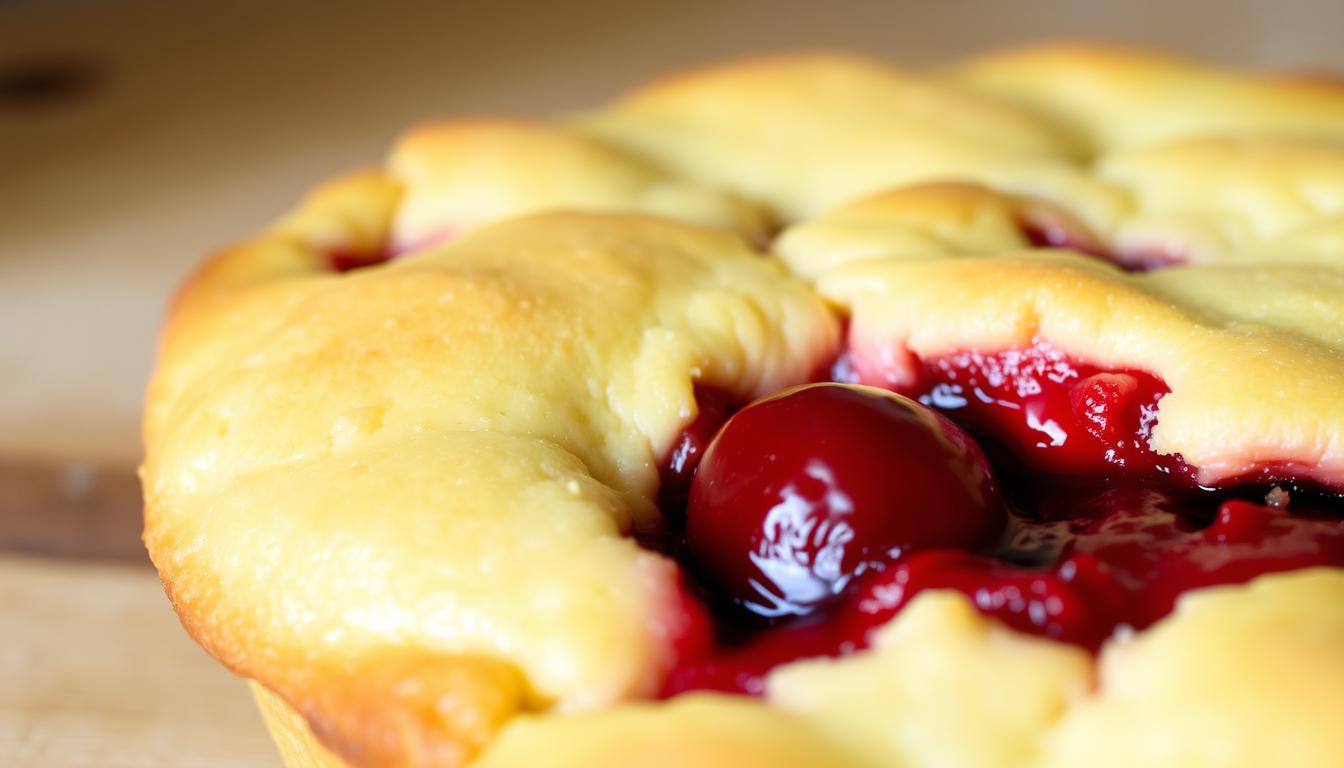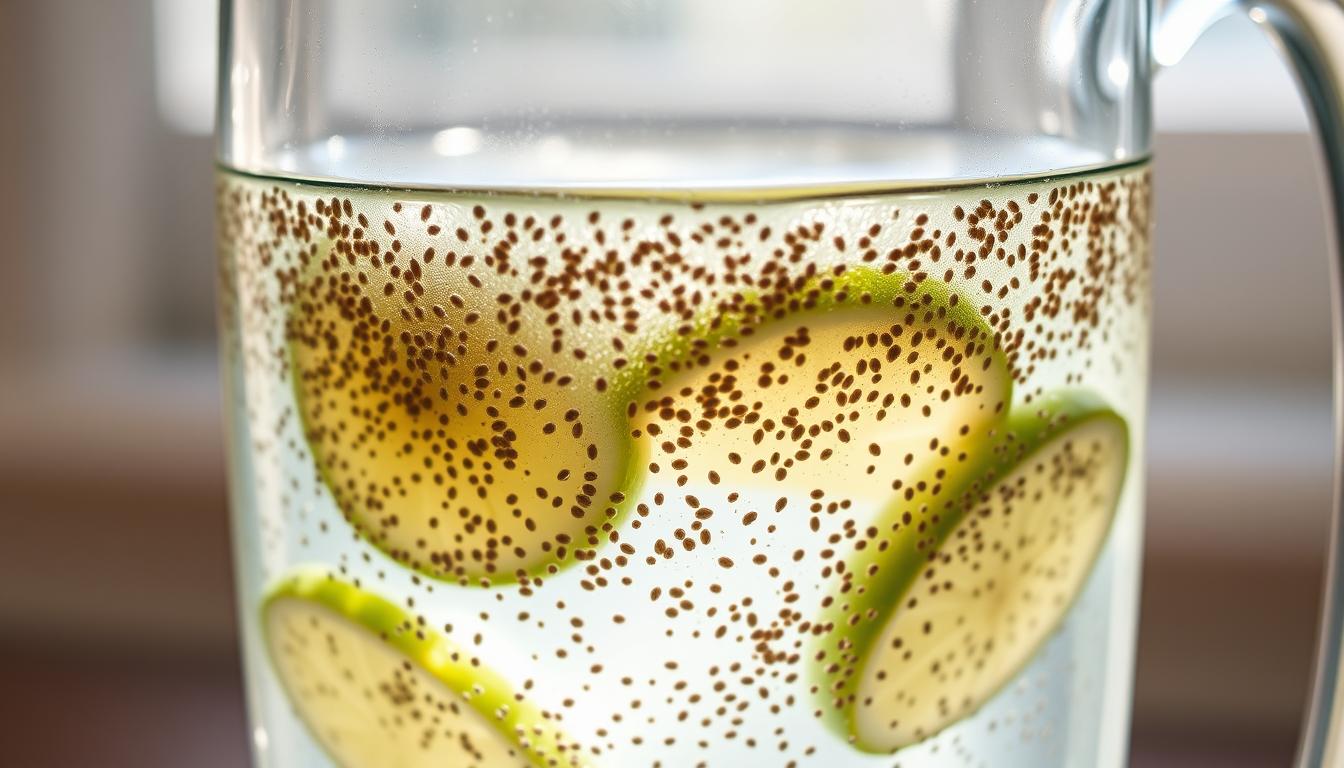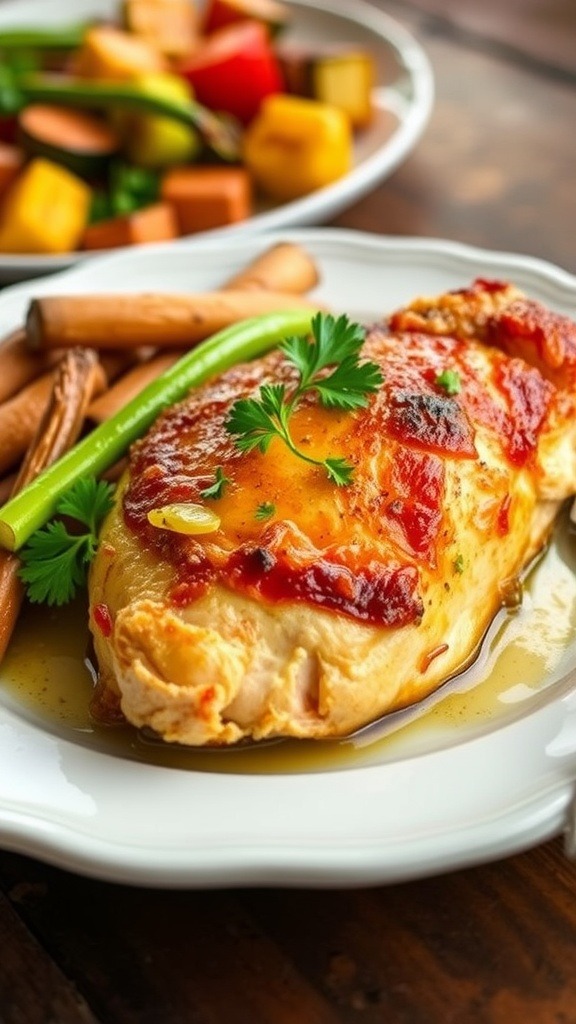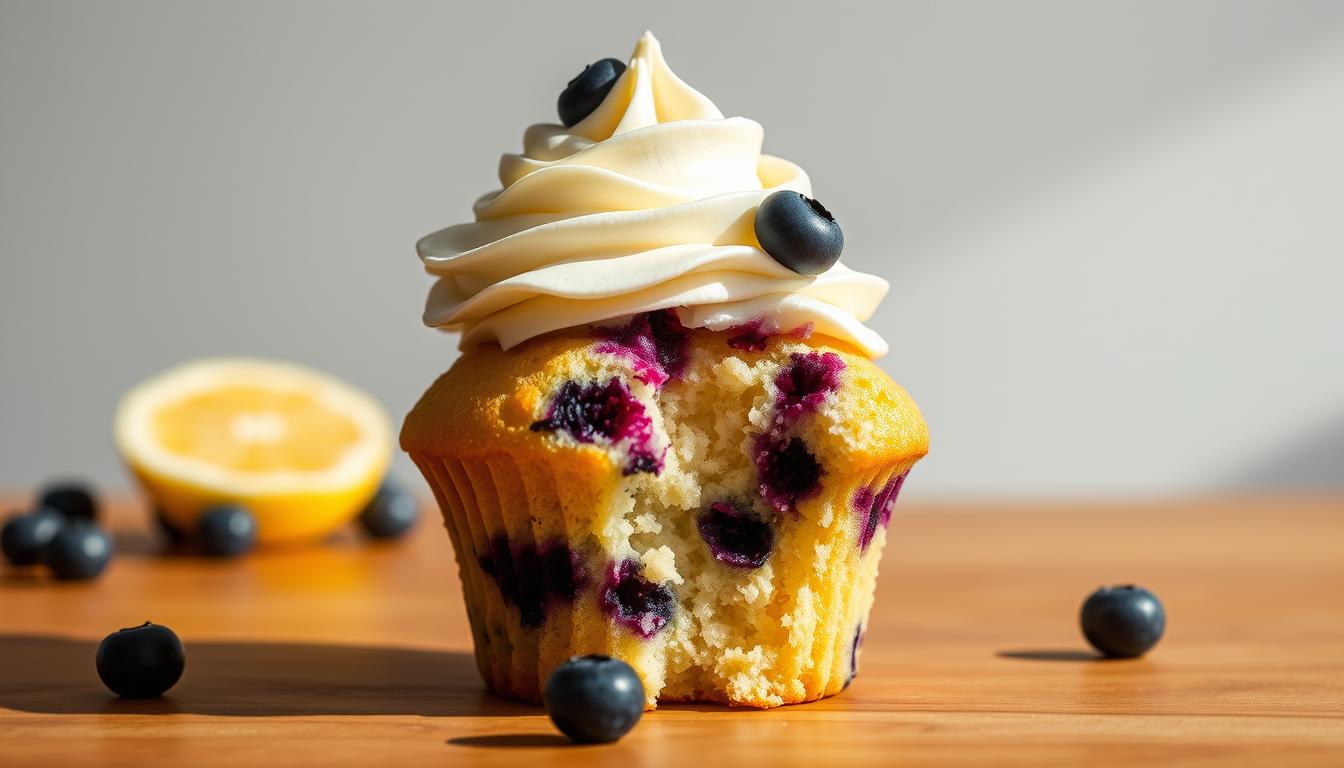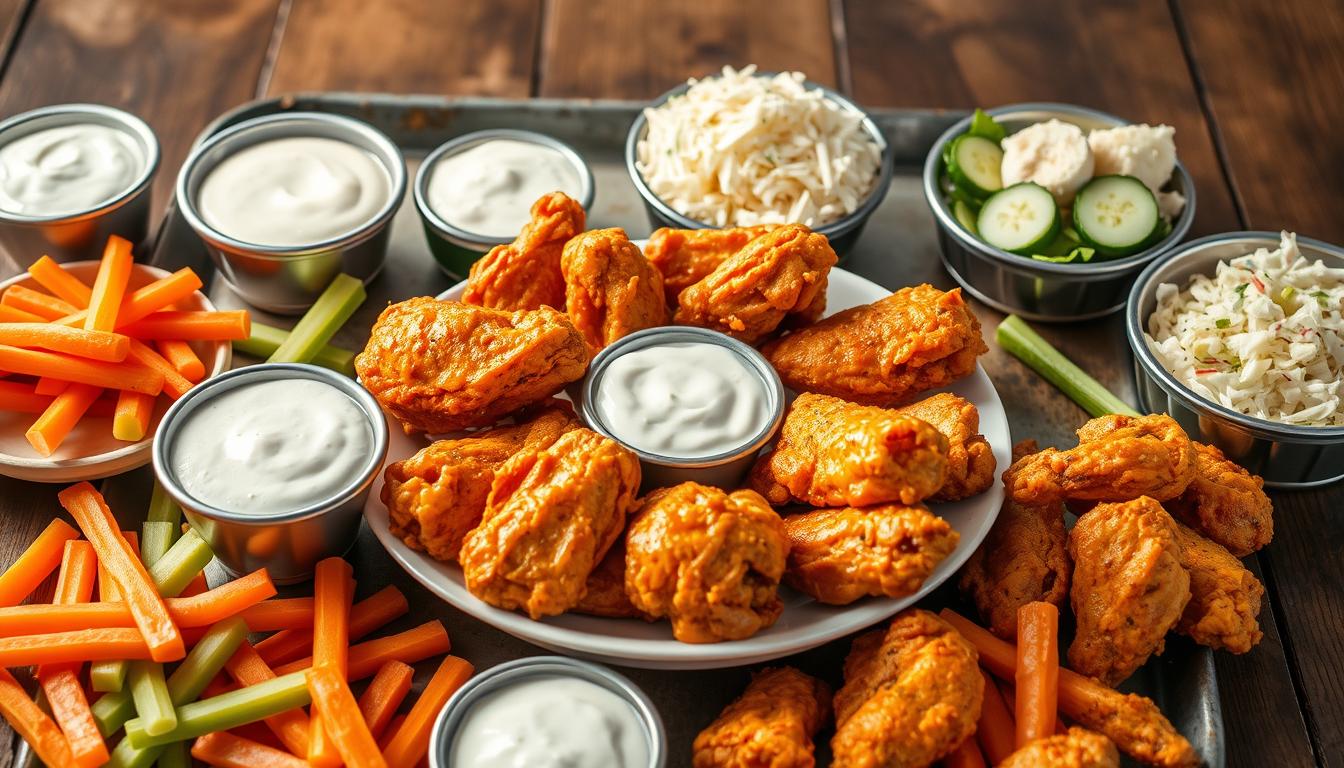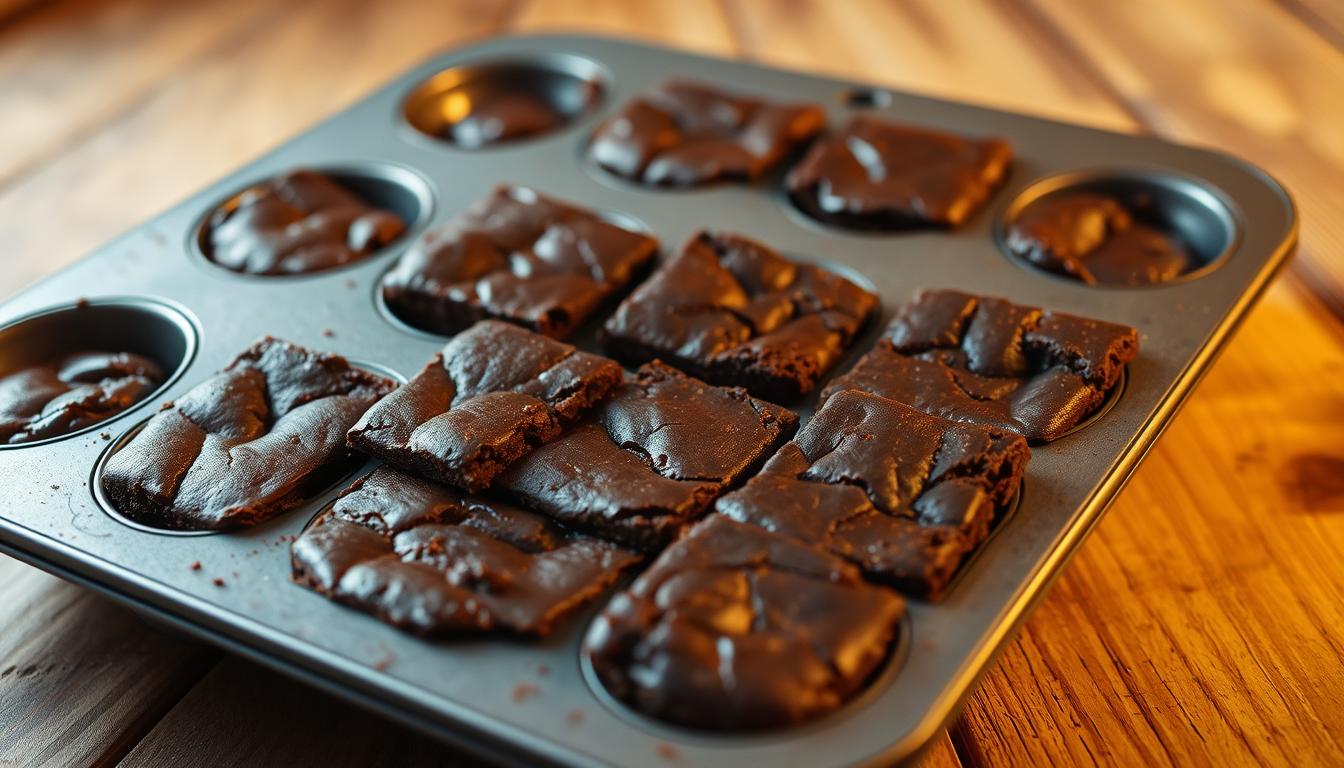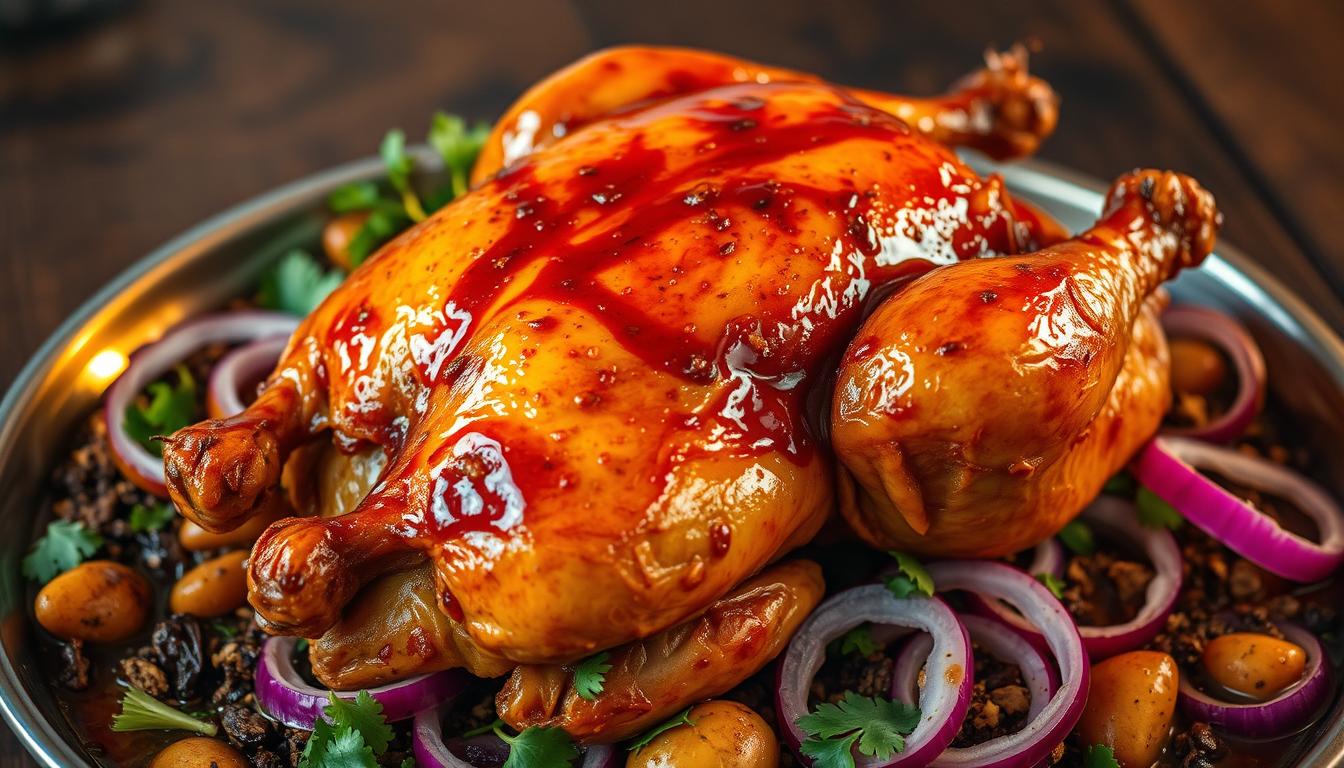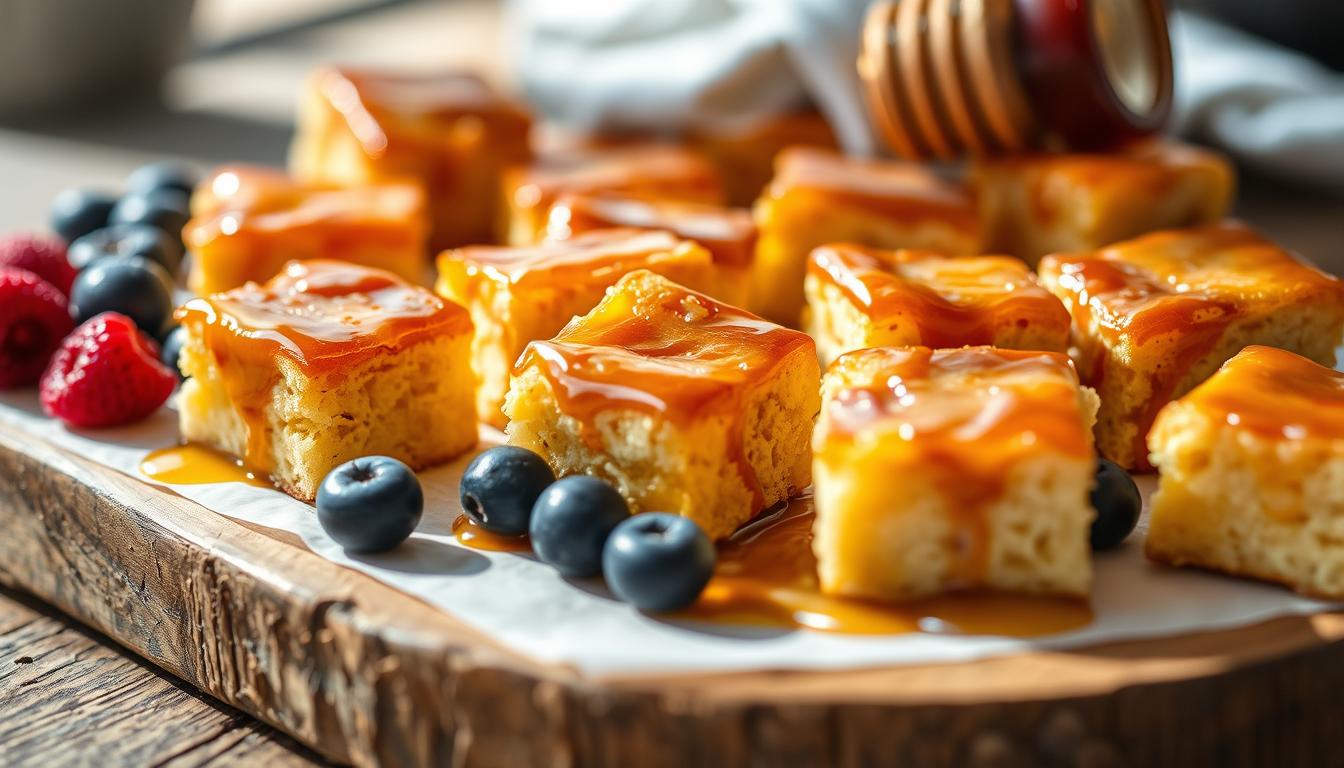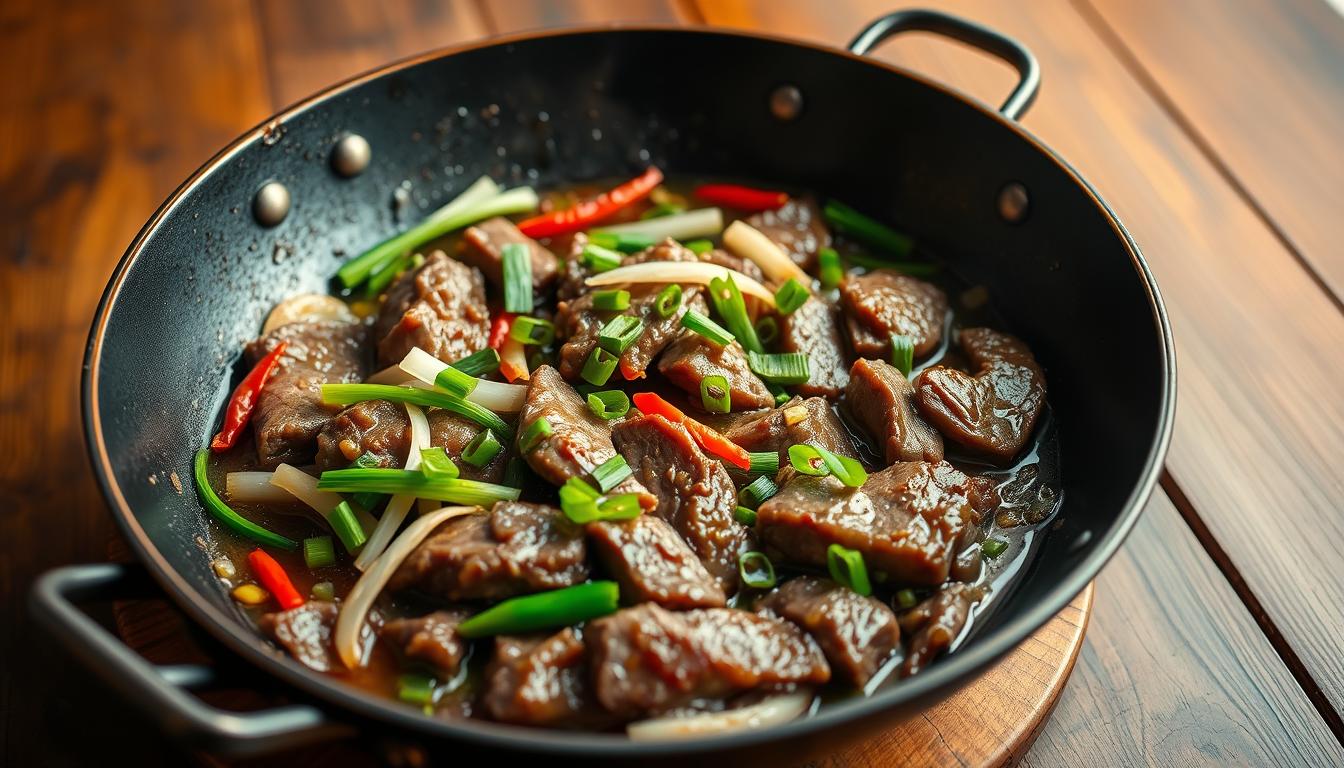Every summer, my family gathers for backyard barbecues. Homemade sourdough hamburger buns are our secret weapon. They turn our burgers into something special. These buns are tender, buttery, and full of wholesome flavor.
Making sourdough hamburger buns is more than just baking. It’s about making memories. With simple ingredients and patience, you can make your kitchen a bakery. You’ll create golden, soft buns that make burger nights unforgettable.
Whether you’re an experienced baker or just starting, making homemade sourdough buns is rewarding. This guide will help you make perfect sourdough hamburger buns. They’ll impress your family and friends.
Key Takeaways
- Sourdough hamburger buns offer superior taste and texture
- Homemade buns are fresher and more nutritious than store-bought
- Basic ingredients and techniques make bun-making accessible
- Patience is key in developing great sourdough flavor
- Customization options allow for unique flavor profiles
What Are Sourdough Hamburger Buns?
Sourdough hamburger buns are a tasty twist on regular burger bread. They offer a special flavor that store-bought buns can’t match. These buns are made with a special fermentation process that turns simple ingredients into amazing bread.
The secret of sourdough buns is their unique making process. Unlike regular bread, they use a fermented starter. This starter gives them a complex flavor and a chewy texture.
Defining Sourdough Hamburger Buns
Sourdough hamburger buns are different from regular buns in several ways:
- Tangy, slightly acidic flavor
- Chewy, robust texture
- Enhanced digestibility
- Natural fermentation process
“Sourdough is not just bread, it’s a culinary art form that transforms simple ingredients into something extraordinary.” – Artisan Baker’s Wisdom
Growing Popularity in Home Baking
Home bakers love sourdough bun recipes for their health and taste benefits. They offer a healthier, tastier option than mass-produced bread. This trend shows a growing interest in authentic, handmade food.
By making your own sourdough hamburger buns, you join a long tradition. It’s about enjoying great flavor, nutrition, and the art of making bread.
Ingredients You Need
Making tasty sourdough hamburger buns starts with picking the right ingredients. Knowing what each part does makes your baking better.
You’ll need a mix of must-haves and nice-to-haves for your buns. The quality of each item affects the buns’ taste and feel.
Essential Ingredients for the Dough
- All-purpose flour (360 grams or 3 cups)
- Active sourdough starter (50 grams or ¼ cup)
- Water (240 grams or 1 cup)
- Honey (30 grams or 1 ½ tablespoons)
- Salt (10 grams or 1 ½ teaspoons)
Optional Ingredients for Enhanced Flavor
- Milk (for richer texture)
- Eggs (for increased protein)
- Butter (for additional richness)
Each ingredient is key to the buns’ taste and texture. Flour gives them shape, and the sourdough starter adds flavor and makes them rise.
| Ingredient | Quantity | Purpose |
|---|---|---|
| All-purpose flour | 360g | Provides structure and volume |
| Sourdough starter | 50g | Fermentation and flavor development |
| Water | 240g | Hydrates flour and activates fermentation |
| Honey | 30g | Adds sweetness and aids browning |
| Salt | 10g | Enhances flavor and controls fermentation |
Pro tip: Use high-quality ingredients for the best sourdough bun ingredients. Fresh, active starter and unbleached flour will make your buns better.
The Process of Making Sourdough Starter
Creating a sourdough starter is the first step in your sourdough bun journey. This mix of flour and water becomes a home for wild yeast and bacteria. It turns your buns from good to great.
A sourdough starter is more than a leavening agent. It’s a culinary adventure that adds depth and character to your baking. Unlike commercial yeast, it develops unique flavors through fermentation.
Understanding Sourdough Starter Basics
To start your sourdough starter journey, you need just two things:
- Unbleached all-purpose flour
- Filtered water
Creating Your Starter
Here are the key steps for a successful sourdough starter:
- Mix equal parts flour and water (by weight)
- Let the mixture sit at room temperature (75-80°F)
- Discard and feed your starter daily
- Watch for bubbles and rising activity
“A good sourdough starter is like a living pet – it needs regular feeding and attention!” – Professional Baker
Your starter will take 5-7 days to become fully active. Look for these signs of a healthy starter:
- Consistent bubbling
- Doubling in volume within 6-8 hours after feeding
- Pleasantly tangy smell
Patience is key in your sourdough bun tutorial. A mature starter will give your buns rich flavor and perfect rise.
Mixing the Dough
Making the perfect sourdough bun recipe needs careful mixing. Mixing the ingredients right is key for a tasty homemade bun with great texture and flavor.
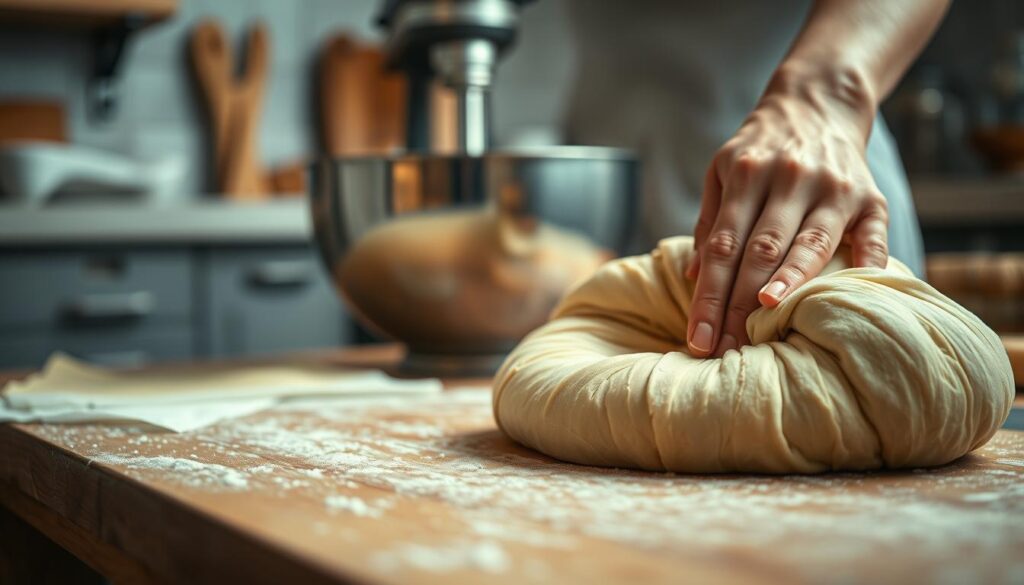
- Begin by mixing your dry ingredients in a big bowl
- Make a well in the center and add your levain
- Mix until you get a shaggy dough
- Slowly add softened butter
Achieving the Perfect Dough Consistency
The dough’s consistency is very important for homemade buns. It should be slightly tacky but not too wet. Here are some tips for the perfect texture:
- Try to keep the dough at 76°F (24°C)
- Use high-protein bread flour for better structure
- Knead until the dough is smooth, like a windowpane
Mixing Techniques
You have two main ways to mix your sourdough bun recipe:
- Stand Mixer Method: Mix on medium-low speed for about 2 minutes
- Hand Mixing Method: Knead until all ingredients are well mixed
Pro tip: When adding butter, do it slowly – about 30 seconds per tablespoon. This helps the butter mix evenly and keeps the dough’s shape for perfect buns.
First Rise: Bulk Fermentation
The bulk fermentation stage is key in making the best sourdough burger buns. It turns your sourdough bun baking tips into a tasty reality. Your dough will grow, making the buns light and airy.
Your sourdough dough changes a lot during this time. It usually takes 10-13 hours at room temperature. This lets natural yeasts work their magic. Keep the area around 68°F (20°C) for the best results.
Key Fermentation Considerations
- Monitor dough volume: The mixture should double in size
- Watch for air bubbles developing throughout the dough
- Maintain consistent temperature between 68-75°F
- Avoid drafty or cold kitchen areas
Temperature and Timing Details
Professional bakers know temperature is crucial. Your sourdough starter and dough need specific conditions. This ensures they develop rich flavors.
Pro tip: Use a clear container to track your dough’s rise precisely!
During bulk fermentation, your dough becomes more elastic. It develops a network of gluten strands. This creates the signature texture that makes homemade sourdough buns special.
Shaping the Buns
Learning to shape homemade sourdough buns is key to making them look professional. The right method can take your sourdough bun tutorial from good to great.
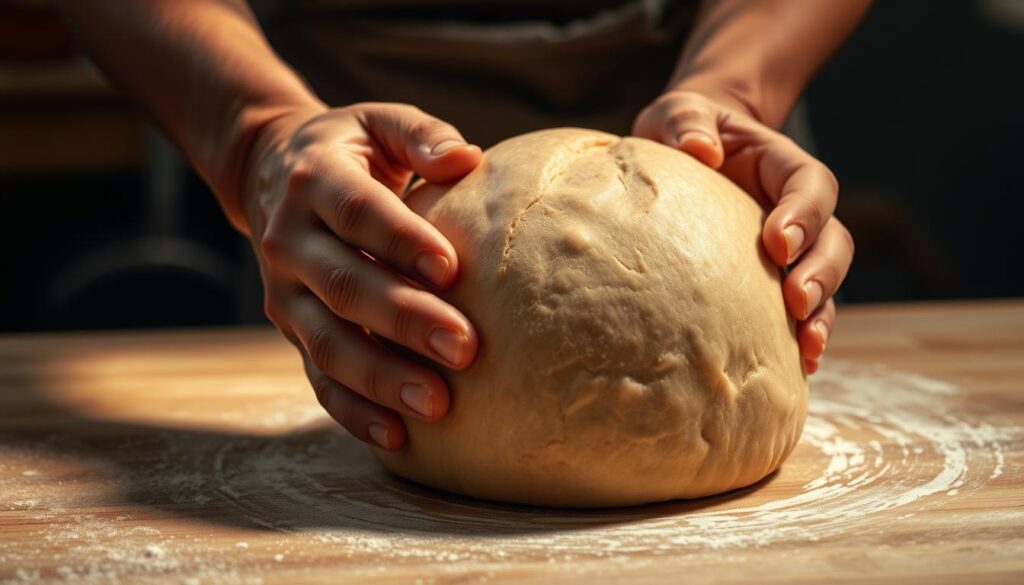
When working with your sourdough dough, precision is important. Divide your dough into equal parts for consistent bun sizes. For standard hamburger buns, aim for about 85-120 grams per bun.
Techniques for Perfect Bun Shaping
- Use a kitchen scale to weigh each dough portion accurately
- Create a smooth surface by gently stretching and tucking the dough
- Roll the dough into tight balls using circular motions on your work surface
- Develop a uniform exterior skin for better rise and appearance
Common Shaping Mistakes to Avoid
In your sourdough bun tutorial, watch out for these potential pitfalls:
- Overworking the dough can lead to tough, dense buns
- Using too much flour can dry out your homemade sourdough buns
- Failing to create surface tension will result in flat, uninspired buns
Pro tip: If your dough feels sticky, refrigerate it for 15 minutes. This helps manage moisture and makes shaping easier. After shaping, let your buns proof for 1-2 hours before baking at 375°F for 20-25 minutes.
Second Rise: Proofing the Buns
The second rise, or proofing stage, is key for the best sourdough burger buns. It turns simple ingredients into light, airy buns with great texture and flavor.
During proofing, your sourdough buns get their final shape and size. This step usually takes 3-5 hours at room temperature. Several factors affect this time:
- Room temperature
- Humidity levels
- Starter strength
- Dough hydration
Understanding the Proofing Process
Proofing is both science and art for bakers. You aim for buns that are doubled in size and feel light. The “poke test” checks if they’re ready:
- Gently press the dough with your finger
- If the indentation slowly springs back, they’re ready
- If it rebounds quickly, they need more time
- If the dent remains, they’re over-proofed
Temperature and Timing Considerations
Warm environments of 75-80°F are best for proofing. Cooler temperatures slow down fermentation, while warmer spots speed it up. A consistent environment ensures even rising and the best flavor.
Baking the Buns
Making perfect sourdough hamburger buns needs precision and care. The oven is where they transform into golden, crusty buns with a soft inside.
Start by knowing your oven well. Heat it to 425°F (220°C) for a crispy outside and soft inside.
Oven Temperature and Timing
Pay close attention to oven temperature and timing. Here’s what to do:
- Preheat oven to 425°F (220°C)
- Bake for 15-18 minutes
- Rotate pan halfway through baking
- Check internal temperature reaches 190°F
Tips for a Perfect Crust
For a golden-brown crust, try these tips:
- Brush buns with egg wash for shine
- Create steam by placing a water pan in the oven
- Use parchment paper for even baking
- Allow buns to cool on a wire rack
| Baking Parameter | Recommended Value |
|---|---|
| Oven Temperature | 425°F (220°C) |
| Baking Time | 15-18 minutes |
| Internal Temperature | 190°F |
| Pan Rotation | Halfway through baking |
Your sourdough hamburger buns are done when they’re golden and sound hollow. Being patient ensures they turn out great every time.
Storing and Freezing Sourdough Hamburger Buns
Keeping your homemade sourdough bread buns fresh is important. You can store them to enjoy later. The right storage keeps them tasting great.
Best Practices for Freshness
For a few days, your sourdough buns can stay fresh. Here’s how:
- Store at room temperature in an airtight container
- Keep away from direct sunlight and heat sources
- Consume within 3 days for optimal taste and texture
How to Freeze for Later Use
Freezing is a great way to keep your buns fresh longer. Here’s how to do it right:
- Cool buns completely before freezing
- Wrap each bun individually in plastic wrap
- Place wrapped buns in a freezer-safe zip-top bag
- Remove excess air to prevent freezer burn
- Freeze for up to 3 months
To thaw frozen buns, let them sit at room temperature for an hour. Then, warm them in the oven or toaster. This brings back their original taste and texture.
Pro tip: Always label your frozen buns with the date to keep track of their storage time!
Delicious Ideas for Serving
Your homemade sourdough hamburger buns are perfect for getting creative in the kitchen. They can turn a simple meal into a special occasion. Whether you’re making a classic cheeseburger or trying something new, your buns will make every bite better.
For a classic burger, use juicy beef, crisp lettuce, ripe tomatoes, and sharp cheddar cheese. Vegetarians can enjoy grilled portobello mushrooms or black bean patties. The secret is to mix textures and flavors that show off your buns.
Creative Burger Combinations
Try adding caramelized onions, roasted garlic aioli, or pickled jalapeños for extra flavor. You could also go for blue cheese and fig jam or a lamb burger with tzatziki sauce. Your homemade buns can handle bold flavors and unique combinations.
Perfect Side Pairings
Finish your meal with sides that match your buns’ rustic charm. Sweet potato fries, fresh coleslaw, or a light arugula salad are great choices. Your burger is now ready to wow your family and friends with its artisanal taste and amazing flavors.
FAQ
What makes sourdough hamburger buns different from regular burger buns?
Sourdough hamburger buns have a tangy flavor and a chewier texture. They are made through a natural fermentation process. This makes them more digestible and possibly healthier than regular buns.
How long does it take to make sourdough hamburger buns from scratch?
Making sourdough hamburger buns takes 12-24 hours. This includes creating the starter, mixing the dough, and baking. You’ll spend about 1-2 hours actively preparing, with most time for fermentation and rising.
Can I make sourdough hamburger buns without a stand mixer?
Yes, you can make them by hand. While a stand mixer helps, hand-mixing works well too. Just be ready to knead a lot to get the dough right.
How long can I store homemade sourdough hamburger buns?
Store them at room temperature for 2-3 days in an airtight container. For longer, freeze them for up to 3 months. Wrap each bun and put them in a freezer-safe bag to keep them fresh.
Do I need a special type of flour to make sourdough hamburger buns?
Bread flour is best for its high protein content. But, all-purpose flour works too. High-protein flour gives the best texture for your buns.
Can I add herbs or other flavors to my sourdough hamburger buns?
Yes! Add dried herbs like rosemary or thyme, or grated cheese and garlic to the dough. These can make your buns taste unique and delicious.
What if my sourdough starter isn’t very active?
If your starter is weak, feed it more often and keep it warm. Use equal parts flour and water for feeding. Discard part of the starter before each feeding to keep it strong.
How can I tell if my sourdough hamburger buns are properly proofed?
Use the “poke test” to check. Press your finger into the dough. If it springs back slowly, it’s ready. If it springs back fast, it needs more time. If it doesn’t spring back, it’s over-proofed.


